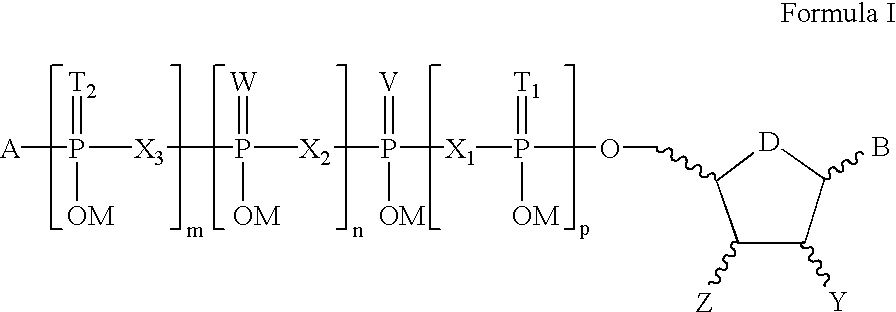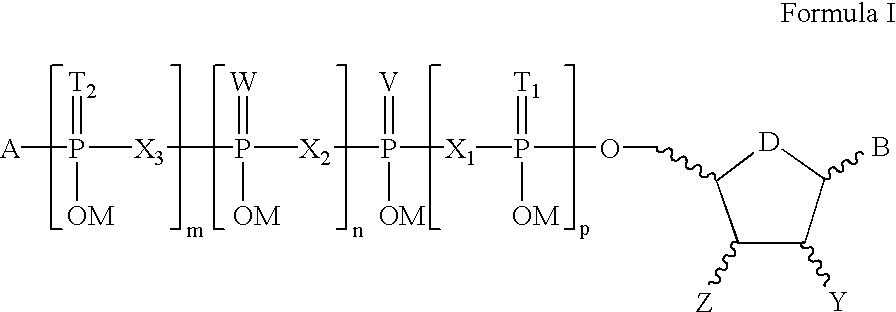Compositions for treating epithelial and retinal tissue diseases
a retinal tissue and compound technology, applied in the field of compound compounds, can solve the problems of uncharacterized physiological roles of p2y receptors in the nervous system, irreversible blindness, and harmful immunologic reactions on subsequent exposures, so as to diagnose or treat epithelial diseases, and prevent the incidence of epithelial tissue diseases
- Summary
- Abstract
- Description
- Claims
- Application Information
AI Technical Summary
Benefits of technology
Problems solved by technology
Method used
Image
Examples
example 1
γ-(n-propyl)-uridine 5′-triphosphate
Uridine 5′-triphosphate, ditributylammonium salt ( 106 mg, 0.124 mmol) dissolved in dry N,N dimethylformamide (400 uL) was treated with N,N′-dicyclohexlycarbodiimide (33.4 mg, 0.162 mmol) for one hour at room temperature. After verifying that there was complete conversion to the cyclical trimetaphosphate by 31P NMR, tributylamine (88 μL, 0.373 mmol) and excess n-propanol (1 mL) were added and the reaction mixture heated to 65° C. for 2.5 days. HPLC (AX300, gradient from 75% water / 25% acetonitrile to 75% 0.5 M KH2PO4 over 20 min, 1 mL / min, monitor at 260 nm) showed >90% conversion to product, so the solvents were removed on a rotary evaporator. The product was purified by semi-preparative HPLC (AX300, gradient from 75% water / 25% acetonitrile to 75% 1 M ammonium acetate / 25% acetonitrile over 20 min, 2 mL / min, monitor at 260 nm) yielding 19.5 mg (28%) of the title product.
1H NMR (D2O, 300 MHz): δ 7.78 (d, 1H), 5.79 (m, 2H), 4.19 (M, 2H), 4.04 (m, 3H)...
example 2
γ-(2-propyl)-uridine 5′-triphosphate
The title product was obtained from the reaction between uridine 5′-triphosphate and 2-propyl alcohol, according to the method of example 1. Yield=14%.
1H NMR (D2O, 300 MHz): δ 7.80 (d, 1H), 5.81 (m, 2H), 4.23 (M, 1H), 4.11 (m, 2H), 4.07 (m, 3H), 1.10 (d, 6H). 31P NMR(D2O, 121.47 MHz): δ−9.60 (d, 1P), −10.34 (d, 1P), −21.98 (t, 1P).
example 3
γ-(n-butyl)-uridine 5′-triphosphate
The title product was obtained from the reaction between uridine 5′-triphosphate and n-butyl alcohol, according to the method of example 1. Yield=39%.
1H NMR (D2O, 300 MHz): δ 7.82 (d, 1H), 5.83 (m, 2H), 4.22 (M, 1H), 4.11 (m, 3H), 3.80 (q, 2H), 1.46 (t, 2H), 1.21 (q, 2H), 0.72 (t, 3H). 31P NMR (D2O, 121.47 MHz): δ−9.44 (d, 1P),−10.18 (d, 1P), −21.82 (t, 1P).
PUM
 Login to View More
Login to View More Abstract
Description
Claims
Application Information
 Login to View More
Login to View More - R&D
- Intellectual Property
- Life Sciences
- Materials
- Tech Scout
- Unparalleled Data Quality
- Higher Quality Content
- 60% Fewer Hallucinations
Browse by: Latest US Patents, China's latest patents, Technical Efficacy Thesaurus, Application Domain, Technology Topic, Popular Technical Reports.
© 2025 PatSnap. All rights reserved.Legal|Privacy policy|Modern Slavery Act Transparency Statement|Sitemap|About US| Contact US: help@patsnap.com



